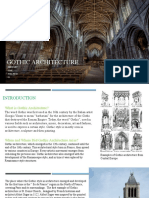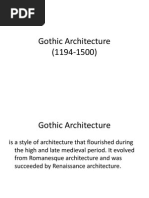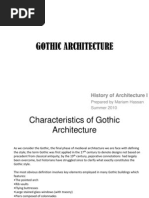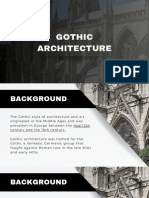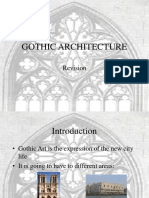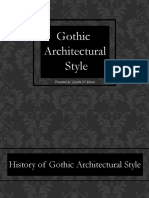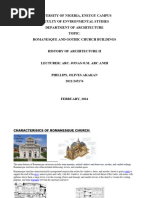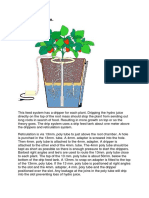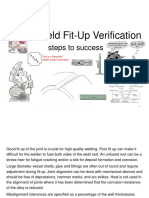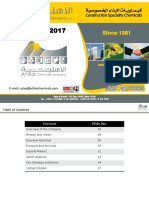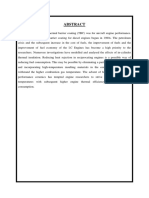0 ratings0% found this document useful (0 votes)
27 viewsStructure
Structure
Uploaded by
Nahom GetachewThe document discusses key structural elements and characteristics of Gothic architecture, including the pointed arch, vaulting, height, emphasis on verticality, large windows, and majestic facades. The pointed arch allowed for taller, irregularly shaped structures with ribbed vaulting to distribute weight. Gothic cathedrals featured towering spires, vertical buttresses, and extensive use of stained glass windows, emphasizing light, height, and verticality to evoke spirituality. Major facades often had two towers to create a powerful first impression on worshippers.
Copyright:
© All Rights Reserved
Available Formats
Download as PPTX, PDF, TXT or read online from Scribd
Structure
Structure
Uploaded by
Nahom Getachew0 ratings0% found this document useful (0 votes)
27 views13 pagesThe document discusses key structural elements and characteristics of Gothic architecture, including the pointed arch, vaulting, height, emphasis on verticality, large windows, and majestic facades. The pointed arch allowed for taller, irregularly shaped structures with ribbed vaulting to distribute weight. Gothic cathedrals featured towering spires, vertical buttresses, and extensive use of stained glass windows, emphasizing light, height, and verticality to evoke spirituality. Major facades often had two towers to create a powerful first impression on worshippers.
Original Title
Untitled
Copyright
© © All Rights Reserved
Available Formats
PPTX, PDF, TXT or read online from Scribd
Share this document
Did you find this document useful?
Is this content inappropriate?
The document discusses key structural elements and characteristics of Gothic architecture, including the pointed arch, vaulting, height, emphasis on verticality, large windows, and majestic facades. The pointed arch allowed for taller, irregularly shaped structures with ribbed vaulting to distribute weight. Gothic cathedrals featured towering spires, vertical buttresses, and extensive use of stained glass windows, emphasizing light, height, and verticality to evoke spirituality. Major facades often had two towers to create a powerful first impression on worshippers.
Copyright:
© All Rights Reserved
Available Formats
Download as PPTX, PDF, TXT or read online from Scribd
Download as pptx, pdf, or txt
0 ratings0% found this document useful (0 votes)
27 views13 pagesStructure
Structure
Uploaded by
Nahom GetachewThe document discusses key structural elements and characteristics of Gothic architecture, including the pointed arch, vaulting, height, emphasis on verticality, large windows, and majestic facades. The pointed arch allowed for taller, irregularly shaped structures with ribbed vaulting to distribute weight. Gothic cathedrals featured towering spires, vertical buttresses, and extensive use of stained glass windows, emphasizing light, height, and verticality to evoke spirituality. Major facades often had two towers to create a powerful first impression on worshippers.
Copyright:
© All Rights Reserved
Available Formats
Download as PPTX, PDF, TXT or read online from Scribd
Download as pptx, pdf, or txt
You are on page 1of 13
Structure:
• One of the defining characteristics of Gothic
architecture is the pointed arch. Arches of
this type were used in the Near East in
preIslamic as well as Islamic architecture
before they were structurally employed in
medieval architecture, and are thus thought
to have been the inspiration for their use in
France, as at Autun Cathedral, which is
otherwise stylistically Romanesque.
• There was simultaneously a structural evolution towards the
pointed arch, for the purpose of vaulting spaces of irregular
plan, or to bring transverse vaults to the same height as
diagonal vaults.
• Pointed arches also occur extensively in
Romanesque decorative blind arcading, where
semi-circular arches overlap each other in a
simple decorative pattern, and the points are
accidental to the design.
• The Gothic vault, unlike the semi-circular vault
of Roman and Romanesque buildings, can be
used to roof rectangular and irregularly shaped
plans such as trapezoids.
• The other structural advantage is that the
pointed arch channels the weight onto the
bearing piers or columns at a steep angle. This
enabled architects to raise vaults much higher
than was possible in Romanesque architecture.
• While, structurally, use of the pointed arch gave a
greater flexibility to architectural form, it also
gave Gothic architecture a very different and
more vertical visual character to Romanesque.
• In Gothic Architecture the pointed arch is used in
every location where a vaulted shape is called for,
both structural and decorative. Gothic openings
such as doorways, windows, arcades and galleries
have pointed arches.
• Gothic vaulting above spaces both large and small
is usually supported by richly moulded ribs
• Rows of pointed arches upon delicate shafts form
a typical wall decoration known as blind arcading.
• Niches with pointed arches and containing statuary are a
major external feature. The pointed arch lent itself to
elaborate intersecting shapes which developed within
window spaces into complex Gothic tracery forming the
structural support of the largewindows that are
characteristic of the style.
Height
A characteristic of Gothic church architecture is its
height, both absolute and in proportion to its width, the
verticality suggesting an aspiration to Heaven. A section
of the main body of a Gothic church usually shows the
nave as considerably taller than it is wide. The highest
internal vault is at Beauvais Cathedral at 4 m.
Externally, towers and spires are characteristic of Gothic
churches both great and small, the number and
positioning being one of the greatest variables in Gothic
architecture. The height of the at 160m.
• In Italy, the tower, if present, is almost always detached from
the building, as at Florence Cathedral, and is often from an
earlier structure.
• In France and Spain, two towers on the front is the norm. In
England, Germany and Scandinavia this is often the
arrangement, but an English cathedral may also be
surmounted by an enormous tower at the crossing.
Vertical Emphasis:
• The pointed arch lends itself to a suggestion of
height. This appearance is characteristically
further enhanced by both the architectural
features and the decoration of the building.
• On the exterior, the verticality is emphasized in
a major way by the towers and spires and in a
lesser way by strongly projecting vertical
buttresses, by narrow half-columns called
attached shafts which often pass through several
storeys of the building, by long narrow windows,
vertical moldings around doors and figurative
sculpture which emphasizes the vertical and is
often attenuated.
• The roofline, gable ends, buttresses and other parts of the building
are often terminated by small pinnacles, Milan Cathedral being an
extreme example in the use of this form of decoration.
• On the interior of the building attached shafts often sweep unbroken
from floor to ceiling and meet the ribs of the vault, like a tall tree
spreading into branches.
• The verticals are generally repeated in the treatment of the
windows and wall surfaces. In many Gothic churches,
particularly in France, and in the Perpendicular period of
English Gothic architecture, the treatment of vertical
elements in gallery and window tracery creates a strongly
unifying feature that counteracts the horizontal divisions of
the interior structure.
Light
One of the most distinctive characteristics of Gothic architecture is the
expansive area of the windows are very large size.
The increase in size between windows of the Romanesque and Gothic
periods is related to the use of the ribbed vault, and in particular, the
pointed ribbed vault which channeled the weight to a supporting shaft
with less outward thrust than a semicircular vault. Walls did not need
to be so weighty
Through the Gothic period, due to the versatility of the pointed arch, the
structure of Gothic windows developed from simple openings to
immensely rich and decorative sculptural designs. The windows were very
often filled with stained glass which added a dimension of colour to the
light within the building, as well as providing a medium for figurative and
narrative art.
Majesty (dignity)
: The façade of a large church or cathedral, often
referred to as the West Front, is generally designed
to create a powerful impression on the approaching
worshipper, demonstrating both the might of God,
and the might of the institution that it represents.
The West Front of a French cathedral and many
English, Spanish and German cathedrals generally
has two towers, which, particularly in France,
express an enormous diversity of form and
decoration. However some German cathedrals have
only one tower located in the middle of the façade.
You might also like
- Gothic ArchitectureDocument103 pagesGothic ArchitecturePrakriti Goel100% (5)
- Medieval ArchitectureDocument24 pagesMedieval Architectureリ0315No ratings yet
- 4) Medieval ArtDocument37 pages4) Medieval ArtYashika TharwaniNo ratings yet
- Gothic Architecture: Hebin Aby Ionic Roll No.18 S4Document10 pagesGothic Architecture: Hebin Aby Ionic Roll No.18 S4HebinNo ratings yet
- Gothic ArchitectureDocument44 pagesGothic ArchitectureHIRA SHABBIR100% (2)
- Gothic ArchitectureDocument30 pagesGothic ArchitectureParth AgarwalNo ratings yet
- Gothic Architecture - Lecture NotesDocument27 pagesGothic Architecture - Lecture NotesLawrence Babatunde OgunsanyaNo ratings yet
- GothicDocument20 pagesGothicSheena Gomez100% (1)
- Gothic VS Romanesque Style Research: August 2017Document8 pagesGothic VS Romanesque Style Research: August 2017Chun ReconzzNo ratings yet
- Gothic Architecture: Introduction To Society and Culture of 1150 - 1350 AD in EuropeDocument32 pagesGothic Architecture: Introduction To Society and Culture of 1150 - 1350 AD in EuropeSayed Zabarjed100% (1)
- Gothic CDocument24 pagesGothic Cvaishnavi goelNo ratings yet
- Gothic ArchitectureDocument26 pagesGothic ArchitectureFrenchie AdriaticoNo ratings yet
- Gothic ArchitectureDocument13 pagesGothic ArchitectureMohamed FaseehunNo ratings yet
- GothicDocument52 pagesGothicAlphy Joseph100% (1)
- Gothic ArchitectureDocument50 pagesGothic ArchitectureKreya PatelNo ratings yet
- Gothic ArchitectureDocument16 pagesGothic ArchitecturedandansarabiaNo ratings yet
- Gothic Architecture: History of Architecture-IVDocument39 pagesGothic Architecture: History of Architecture-IVVanshika DograNo ratings yet
- Gothic Architecture Is A Style of Architecture That Flourished During The High and LateDocument8 pagesGothic Architecture Is A Style of Architecture That Flourished During The High and LateOuahidAbdouhNo ratings yet
- Gothic ArchitectureDocument18 pagesGothic Architecturenyash2707No ratings yet
- AntiquityDocument49 pagesAntiquityKRUTI DESAINo ratings yet
- Essay 1 Features of Gothic Architecture With Suitable Examples (U Can Explain With Notre Dame)Document2 pagesEssay 1 Features of Gothic Architecture With Suitable Examples (U Can Explain With Notre Dame)Divya Varghese KurumuttathuNo ratings yet
- Gothic Architecture in EuropeDocument21 pagesGothic Architecture in Europehimanshi sharmaNo ratings yet
- 10 Gothic ArchitectureDocument13 pages10 Gothic Architecture4cz0No ratings yet
- Gothic TGDocument31 pagesGothic TGSnowNo ratings yet
- Gothic Art & Architecture (11 To 13 Century) : TH THDocument5 pagesGothic Art & Architecture (11 To 13 Century) : TH THAnushkaNo ratings yet
- Gothic ArchitectureDocument33 pagesGothic ArchitectureAbegail MartinezNo ratings yet
- Gothic ArchitectureDocument15 pagesGothic Architecturenaman01621No ratings yet
- 1 Gothic PeriodDocument48 pages1 Gothic Periodbhanu sunayana tirumalaNo ratings yet
- Gothic ArchitectureDocument95 pagesGothic ArchitectureJean Angelove Santos100% (1)
- Aarushi Presentation.pptm (2)Document15 pagesAarushi Presentation.pptm (2)Utkarsh TripathiNo ratings yet
- 7 Medival ArchitectureDocument50 pages7 Medival ArchitectureRachana Muppala100% (4)
- 01 - 205 - GothicDocument51 pages01 - 205 - GothicAlex AmburgoNo ratings yet
- Gothic ArchitectureDocument31 pagesGothic ArchitectureNounou cr7No ratings yet
- Gothic Art and ArchitectureDocument108 pagesGothic Art and ArchitectureJ V100% (1)
- Basic ShapeBasic Shapes of Gothic Arches and Stylistic Characters.Document9 pagesBasic ShapeBasic Shapes of Gothic Arches and Stylistic Characters.Guzun Diana100% (1)
- Engleza 3Document3 pagesEngleza 3Nicolae TopalNo ratings yet
- Gothic Architecture in Medieval EuropeDocument6 pagesGothic Architecture in Medieval EuropeNandita SharmaNo ratings yet
- Gothic Architecture 1211364943753656 9Document24 pagesGothic Architecture 1211364943753656 9Lawrence Conanan100% (1)
- Architecture VocabularyDocument6 pagesArchitecture VocabularyVilceanu CrinaNo ratings yet
- GOTHIC ARCHITECTURE FRMDocument23 pagesGOTHIC ARCHITECTURE FRMkarthikaNo ratings yet
- The Age of The Cathedrals.5Document8 pagesThe Age of The Cathedrals.5Pave mNo ratings yet
- CM1 - HOA2 - Gothic ArchitectureDocument24 pagesCM1 - HOA2 - Gothic ArchitectureNina Lim LimNo ratings yet
- Gothic Architectural StyleDocument32 pagesGothic Architectural StyleCriselle Naive MacasNo ratings yet
- Romanesque ArchitectureDocument15 pagesRomanesque ArchitectureRida Irfan100% (1)
- Romanesque Architecture Is An Architectural Style of Europe - Time Period 800 AD-1100 ADDocument46 pagesRomanesque Architecture Is An Architectural Style of Europe - Time Period 800 AD-1100 ADPrashant NehraNo ratings yet
- 3 Important Questions in Gothic ArchitectureDocument9 pages3 Important Questions in Gothic ArchitectureDivya Varghese KurumuttathuNo ratings yet
- Gothic ArchitectureDocument32 pagesGothic ArchitectureRyan AbuzoNo ratings yet
- Gothic Architecture: Now Unavailable inDocument23 pagesGothic Architecture: Now Unavailable inFerik SetiawanNo ratings yet
- Hoa 2 - GothicDocument89 pagesHoa 2 - GothicMo Padilla100% (2)
- Gothic Period: Medieval Period Romanesque Architecture Renaissance ArchitectureDocument7 pagesGothic Period: Medieval Period Romanesque Architecture Renaissance ArchitectureJuvilasri VigneshNo ratings yet
- GothicDocument5 pagesGothicJesus is lordNo ratings yet
- Italian GothicDocument18 pagesItalian GothicJY 143No ratings yet
- Report. Terekhova A-22Document3 pagesReport. Terekhova A-22Владислава ТереховаNo ratings yet
- Gothic ArchitectureDocument31 pagesGothic Architectureanasali786mughalaliNo ratings yet
- Gothic ArchitectureDocument52 pagesGothic ArchitectureSeptimiuNo ratings yet
- Gothic Architecture: Submitted To: Mr. Jai SonkerDocument26 pagesGothic Architecture: Submitted To: Mr. Jai Sonkere ritse100% (2)
- Gothic ArchitectureDocument18 pagesGothic ArchitectureArham HameedNo ratings yet
- HistoryDocument6 pagesHistoryOlives PhillipsNo ratings yet
- How Gothic Architecture Started: A Comprehensive Guide to Exploring Gothic Architecture History"From EverandHow Gothic Architecture Started: A Comprehensive Guide to Exploring Gothic Architecture History"No ratings yet
- Ten Things Every Designer Should Know When Using Axiem: Best-Practice GuideDocument14 pagesTen Things Every Designer Should Know When Using Axiem: Best-Practice GuideVijayKarthikVenkatasubramanianNo ratings yet
- Feasibility Study ProjectDocument25 pagesFeasibility Study Projectjudytafe91% (11)
- Ohm's Law ExperimentDocument4 pagesOhm's Law ExperimentKshitij PandeyNo ratings yet
- High Resolution UTP Camera: Technical SpecificationsDocument1 pageHigh Resolution UTP Camera: Technical Specificationsnk1969No ratings yet
- Approval Lampu Dinding PhilipDocument2 pagesApproval Lampu Dinding PhilipArip YusupNo ratings yet
- Coldfusion Security CF8Document47 pagesColdfusion Security CF8Ibn Sani Al-WadiyyahNo ratings yet
- 8268H Decoded Formats Supported (2963)Document4 pages8268H Decoded Formats Supported (2963)talita fernanda pontes castelloNo ratings yet
- F170a 23Document108 pagesF170a 23luiscremaschi100% (1)
- 2019 Stoneware Brochure PDFDocument16 pages2019 Stoneware Brochure PDFmaycocolors.ruNo ratings yet
- Drip Feed SystemDocument5 pagesDrip Feed SystemDIGITAL MAXNo ratings yet
- CSIG WS Creating Web ServicesDocument10 pagesCSIG WS Creating Web ServicesPriyanko ChatterjeeNo ratings yet
- Power Generation Footstep - 2Document5 pagesPower Generation Footstep - 2gideykibrom80No ratings yet
- ParametersDocument2 pagesParametersksmkrishnaNo ratings yet
- Weld Fit Up Inspection Employee TrainingDocument10 pagesWeld Fit Up Inspection Employee TrainingBadiuzzama Azmi100% (2)
- After Hours ProcessingDocument3 pagesAfter Hours ProcessingAna100% (1)
- Analysis of Indeterminate Structures: Chapter TwoDocument36 pagesAnalysis of Indeterminate Structures: Chapter TwoJoseph EvangelistaNo ratings yet
- Spreadsheets To BS 8110: The Concrete CentreDocument1 pageSpreadsheets To BS 8110: The Concrete CentreAung MayNo ratings yet
- Ahlia Chemicals Profile 2017Document24 pagesAhlia Chemicals Profile 2017Anonymous kRIjqBLk100% (1)
- Simulation EXAMPLEDocument2 pagesSimulation EXAMPLEPradnyesh DivekarNo ratings yet
- HT - 003 Sanray Lab VM 50Document1 pageHT - 003 Sanray Lab VM 50Sainath AmudaNo ratings yet
- KD 1.3 Hookes Law and ElasticityDocument7 pagesKD 1.3 Hookes Law and Elasticityichylucyaresta0% (2)
- PROFISSIONAL LINE-Compression Driver: Mounting InformationDocument2 pagesPROFISSIONAL LINE-Compression Driver: Mounting InformationDanny BoysieNo ratings yet
- Exercise 02 - BKF1313 Chapter 2 Part 2Document2 pagesExercise 02 - BKF1313 Chapter 2 Part 2Cornelius PhilipNo ratings yet
- Mohammad HashamDocument2 pagesMohammad Hasham3J Solutions BDNo ratings yet
- Proposed Estimate For Construction of Concrete RoadDocument3 pagesProposed Estimate For Construction of Concrete RoadHarish MeesalaNo ratings yet
- Fan Selection HT63JM312-4616Document4 pagesFan Selection HT63JM312-4616glennpanNo ratings yet
- Regulador de Presión LNG E4-110r03-00-0519-00Document54 pagesRegulador de Presión LNG E4-110r03-00-0519-00Andrea ValdezNo ratings yet
- YAPLeeJiuan 2005 PDFDocument126 pagesYAPLeeJiuan 2005 PDFthlim19078656No ratings yet
- Webercol MaxDocument2 pagesWebercol Maxajee doNo ratings yet
- Seminar ReportDocument19 pagesSeminar ReportmujeebNo ratings yet



